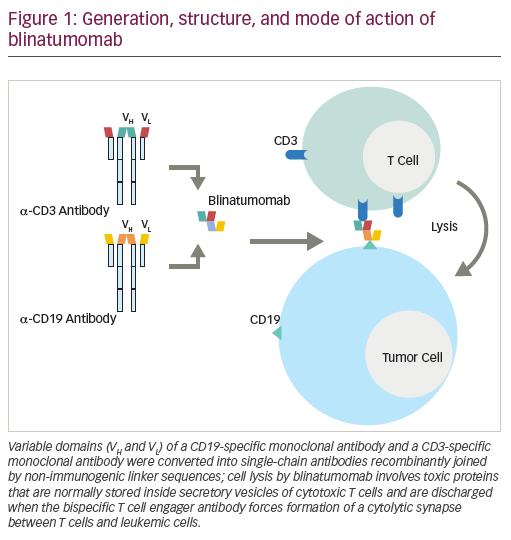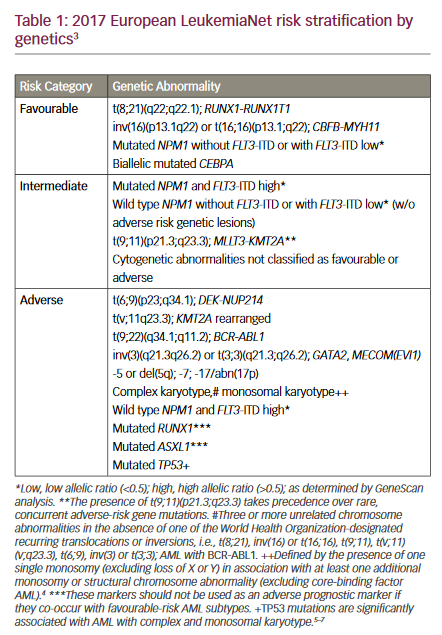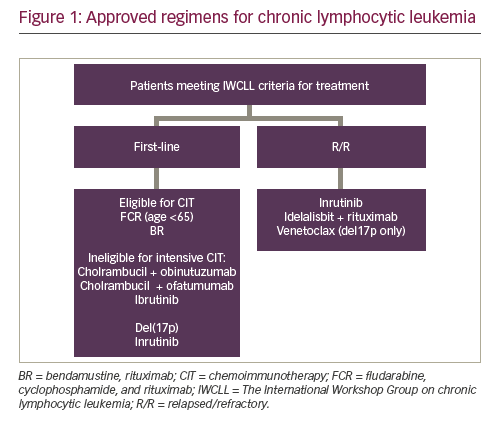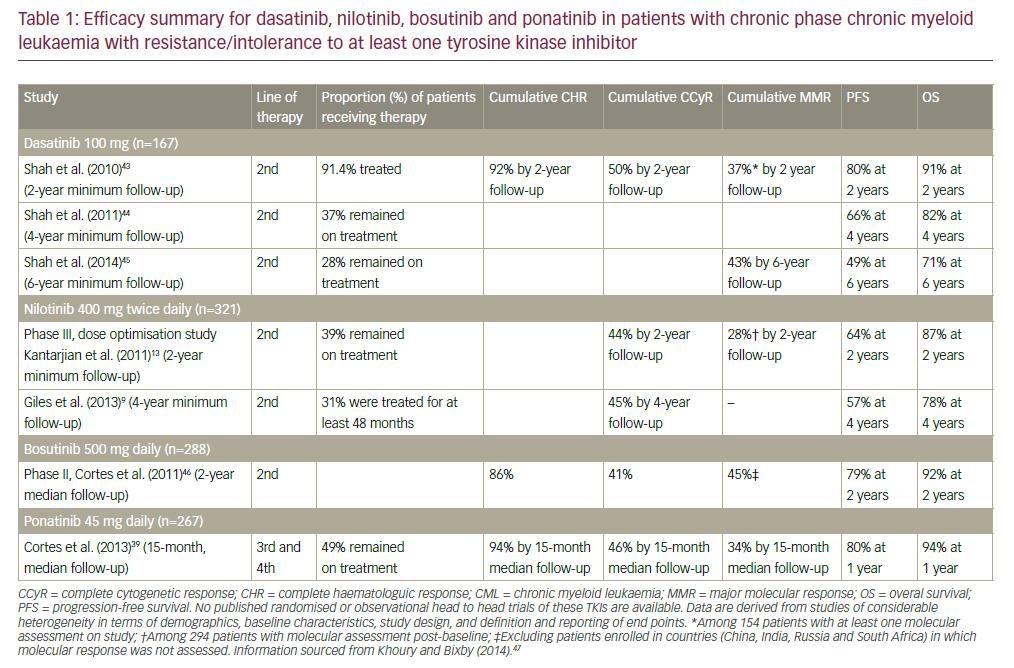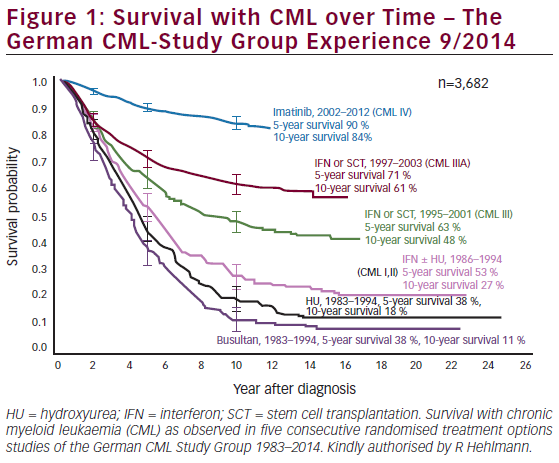CML is a monoclonal stem cell disorder accounting for approximately 20% of adult leukemias.1 The median age at first diagnosis is 60 years and the male-to-female ratio is almost even (1:1.4). Typically, CML develops in three phases. The vast majority of patients (>80%) is diagnosed in the initial chronic phase, which—in the absence of any treatment—lasts for approximately 3–6 years, before patients enter into the advanced and often terminal stages of the disease, called the accelerated phase and/or blast crisis, respectively.2
Typical hematological features of chronic-phase CML are an increase of total leukocyte count, expansion of myeloid progenitor cells in the peripheral blood and bone marrow, thrombocytosis, and splenomegaly. Progression of CML into accelerated phase can be defined as any of the following: blast cells in blood or bone marrow between 15 and 29%; blast cells plus promyelocytes in the peripheral blood or bone marrow above 30% with less than 30% blasts; basophils in the peripheral blood above 20%; or persistent thrombocytopenia.3
Blast crisis CML, commonly associated with a median survival of less than six months, is marked by more than 30% myeloblasts in either bone marrow or blood.
The pivotal genetic abnormality of CML is a reciprocal, balanced chromosomal t(9;22)(q34;q11) translocation also known as the Philadelphia chromosome, which is restricted to the malignant clone and which can be detected cytogenetically or by fluorescent in situ hybridization (FISH) analysis in more than 90% of all patients with CML.4 This chromosomal alteration fuses the Abelson (ABL) tyrosine kinase gene, originally located on chromosome 9, with the breakpoint cluster region (BCR) gene, originally located on chromosome 22, resulting in the BCR-ABL oncogene.5,6 In CML patients the BCR-ABL oncogene generates the p210 BCR-ABL tyrosine kinase that activates specific pathways, resulting in the leukemic phenotype. In summary, CML is defined as a monoclonal, hematopoietic stem cell disorder, caused by the constitutively activated, highly oncogenic p210 BCR-ABL kinase. Imatinib Mesylate
The concept of targeted therapy as a treatment modality of malignant diseases is based on small molecules—kinase inhibitors—aiming at cancer-specific target structures of the malignant cell. Unprecedented therapeutic success was observed when imatinib (Glivec/Gleevec, Novartis Pharma AG), a 2-phenylaminopyrimidine derivative with a low molecular weight of 589.7kD, was designed and developed.7,8 Imatinib is acting as a competitive inhibitor of adenosinetriphosphate (ATP)-dependent phosphorylation of BCR-ABL, freezing the oncoprotein in the inactive and closed conformation, thereby resulting in BCR-ABL dephosphorylation and inactivation.8–10 The specific structure of the ABL catalytic domain, which is incorporated in BCR-ABL, shows a bilobate structure with a smaller N-terminal and a larger C-terminal lobe. The cleft separating these two lobes contains—among other amino acids that are critical for catalysis—an ATP-binding loop (P-loop), as well as the activation loop (A-loop). In the closed and inactive conformation of BCRABL, ATP and substrate binding is prevented through sealing of the catalytic center of the kinase by the A-loop. In contrast, when BCR-ABL turns into the open and active conformation, the A-loop swings away from the catalytic center, allowing access to the catalytic center.11 Pre-clinical models, both in cell culture systems and mouse models, demonstrated activity of this compound, as well as showing proof-ofprincipal in terms of BCR-ABL dephosphorylation.8,11,12 Upon dephosphorylation of BCR-ABL, imatinib reconstitutes apoptosis, normalizes cellular proliferation in cell culture systems, and results in the prevention and regression of BCR-ABL-positive tumor growth in a mouse model system.8,13 Consequently, following phase I and II clinical trials, imatinib was rapidly tested in a pivotal phase III trial—the International Randomized Study of Interferon versus STI-571 (IRIS) trial—which showed superiority of this compound over the previous standard therapy with interferon-alpha (IFN). Imatinib provides an effective and durable therapy for newly diagnosed chronic-phase CML, inducing a complete hematological remission in 98% of the patients.
After a five-year follow-up, imatinib resulted in a complete cytogenetic response (CcyR) rate of 87% compared with 69% after one year, and progression into accelerated-phase or blast crisis occurred at an estimated rate of 7%. Additionally, a lower risk of progression was identified in patients with a CcyR or a three log reduction of BCR-ABL transcripts, and recent data are indicating a decreasing annual rate of progression after two, three and four years of therapy. Grade three or four toxicities diminished over time, confirming the excellent tolerability profile compared with IFN.14
Resistance to Imatinib
However, advanced stages of the disease (accelerated phase and blast crisis), as well as chromosome-positive (Ph+) acute lymphoblastic leukemia (ALL), are associated with a significantly decreased response rate with a median overall survival in each of these patient populations of less than one year.15–17 Moreover, not only in advanced CML but also in late chronic-phase patients, a variety of mechanisms of resistance have been observed that eventually lead to cytogenetic, or even hematological relapse. Most importantly, more than 45 point mutations have been identified that interfere with a proper binding of imatinib in the binding domain. Although not readily investigated, the frequency of point mutations depends on the stage of the disease and seems to be the most abundant mechanism of resistance. Generally, point mutations can occur in both the A- or P-loop, or any other location that ultimately results in a conformational change leading to inadequate or no binding of imatinib. Depending on the localization of those mutations within the binding domain dose escalation of imatinib from 400 to 800mg may efficiently overcome resistance. However, mutations located in the catalytic P-loop hardly respond to dose intensification.
Aside from point mutations, the amplification of the Philadelphia chromosome has been identified as the second most common mechanism of resistance. Here, multiple copies of the Philadelphia translocation significantly elevate the cytosolic BCR-ABL concentration, which can be overcome only by dose escalations on a very low level. Finally, the accumulation of additional chromosomal alterations known as clonal evolution may confer resistance through BCR-ABLindependent mechanisms.
Aside from dose escalation of imatinib, strategies to respond to clinical resistance may include combination therapies with classical anti-leukemic substances, allogeneic stem cell transplantation, or the development of second-generation tyrosine kinase inhibitors with improved mechanisms of action. In most cases, improving kinase inhibitors may include the identification of additional targets on the leukemic clone or the elevation of the binding affinity to the present target structure. However, patients under treatment with imatinib may not only stop therapy because of resistance and relapse of leukemia, but also, in a small but relevant number of patients, because of toxicities. Among these, the most common are fluid retention, muscle cramps, skin rashes, and abnormal laboratory parameters. Approximately 25–30% of patients discontinue imatinib because of intolerance.
Nilotinib
Among the various alternative structures that are currently at different stages of pre-clinical and clinical evaluation is nilotinib, Tasigna® (formerly AMN107). This is similar to imatinib, and is a 2- phenylaminopyrimidine derivative that has been designed following a rational drug design based on the crystal structure of candidate inhibitors that complex with ABL. The pre-clinical characterization of this compound with regard to the interaction with the ABL kinase showed an inhibitory concentration (IC) 50 of <30nM (imatinib: 649nM) that corresponds with an approximately 30-fold increase of binding affinity compared to imatinib. Even more favorable is the observation of comparable IC50 with regard to cytokine receptor (KIT) (158nM) and platelet-derived growth receptor (PDGFR) (53nM), the two additional targets of both imatinib and nilotionib.
Pre-clinical testing showed activity of nilotinib in 32/33 point mutants. In addition, nilotinib was shown to have efficacy at well-tolerated oral doses in mouse studies for CML. Consequently, a phase I study of nilotinib in 97 patients with imatinib-resistant CML in chronic, accelerated, or blast crisis and in nine patients with Ph+ ALL was performed with doses ranging between 50 and 1200mg daily.2 In the chronic-phase patient population of this trial (n=17), complete hematological remissions (CHRs) were demonstrated in 92% and complete cytogenetic remissions in 35%. The nilotinib dose identified for the consecutive phase II trial was 400mg twice a day (BID), which interestingly resulted in plasma concentrations of >1.7 million that are known to effectively inhibit 32/33 point mutation in a cell culture setting. The most recent phase II data are derived from a multicenter, international trial in over 100 centers with nearly 800 patients.19 Patients enrolled into this trial were suffering from either Ph+ CML or ALL, or were diagnosed for hypereosinophilic syndrome or systemic mastocytosis. CML or ALL patients could be enrolled because of either previous imatinib resistance or imatinib intolerance. In the chronic-phase population, imatinib resistance was defined as not having achieved a CHR after at least three months of therapy, no minimal cytogenetic remission after at least six months, or no major cytogenetic remission (MCyR) after at least 12 months of therapy. Alternatively, patients could be enrolled because of secondary resistance, defined as the loss of a previously achieved CHR or MCyR. All resistant patients had to be pre-treated with at least 600mg/day imatinib for three months. In contrast, the definition of imatinib intolerance is, naturally, less stringent. In this study the definition of imatinib intolerance required that imatinib was discontinued and that patients did not have a baseline MCyR. Baseline characteristics of the chronic-phase patients who were evaluated for toxicity (n=318) showed 70.1% imatinib-resistant versus 29.9% imatinib-intolerant patients. The median exposure to nilotinib was 245 days (range 1–502) and the median dose intensity of 796.6mg/day was only insignificantly below the intended dose of 800 mg/day, and is indicative for a relatively good tolerability. Importantly, the chronic-phase study population of this trial included patients with a median age of 58 years (range 21–85) and relatively long disease durations of 57.3 months (range 4.9–275). Therefore, the chronic-phase population of this trial already included intensely pre-treated patients who in a substantial proportion were, aside from imatinib, pre-treated with hydroxyurea, interferon-alpha, busulfan, and systemic chemotherapy.
Efficacy was determined in the first consecutively enrolled 280 patients with at least a six-month follow-up. When only patients without a baseline CHR were considered, the rate of CHR was 74.1%. The MCyR rate in all patients at the same time was 51.8%, without any significant difference in patients who were enrolled because of resistance (50.5%) or intolerance (54.7%). In this relatively short observation time, a median time to progression could not be determined. However, the compound is associated with both a short median time to CHR of one month (range 0.9–8.3 months) and a short median time to MCyR of 2.8 months (range 0.9–11.1).
The toxicity profile of nilotinib is excellent. No clinical grade III/IV nonhematological toxicities were observed at a frequency >3%. The most common toxicities (grade I/II) were skin rashes, headache, and pruritus, not requiring dose modifications in most of the cases. However, a considerable number of patients demonstrated grade III/IV biochemistry abnormalities including hypophosphatemia (10%), lipase elevation (15%), and hyperglycemia (11%). The pathomechanism of these abnormalities is obscure. Nevertheless, normalization of laboratory parameters occurred in individual patients without dose modifications. In none of the patients was any significant—above grade II—fluid retention observed.
In contrast, myelosuppression occurred in a considerable number of patients, reflecting also the therapeutic potential of nilotinib. When all grades of myelotoxicity were considered, anemia occurred in 48.6%, neutropenia in 49.7%, and thrombocytopenia in 57.3% of all cases. But severe (grade III and IV) grades of myelotoxicity occurred in only 7.9% (anemia) to 28.4% (neutropenia and/or thrombocytopenia) with a relatively short median duration of less than 22 days. Most importantly, nilotinib shows a negligible degree of cross-intolerance towards imatinib. In 117 patients with either chronic-phase or accelerated-phase CML in this study, cross-intolerance was observed in only one patient with gastrointestinal toxicity and one patient with liver toxicity.
In summary, nilotinib represents a promising novel therapeutic agent in the treatment of imatinib-resistant or -intolerant chronic-phase CML patients. In contrast to other second-generation kinase inhibitors in this patient population, nilotinib maintains target specificity but widens the spectrum of sensitivity, as a large number of known BCR-ABL mutants are sensitive to this substance.







